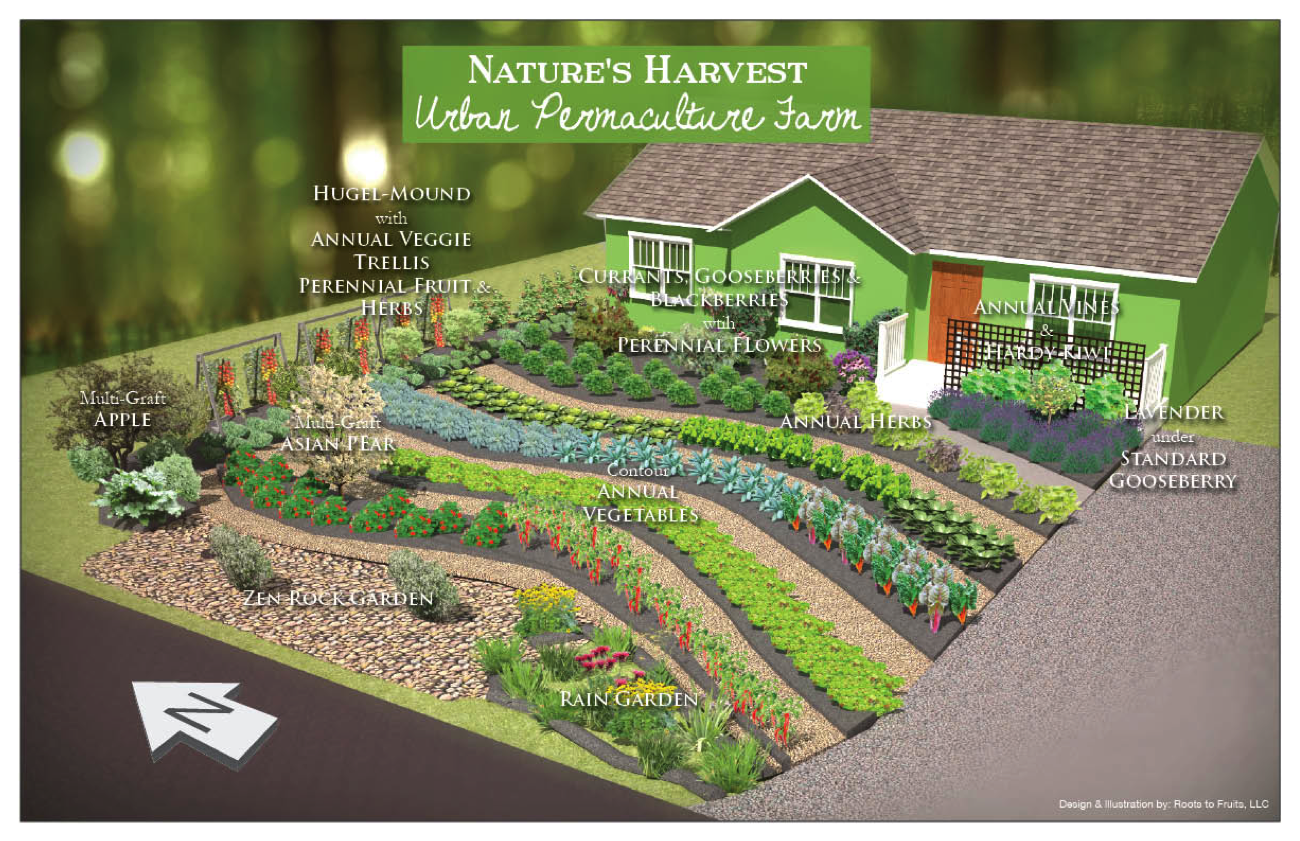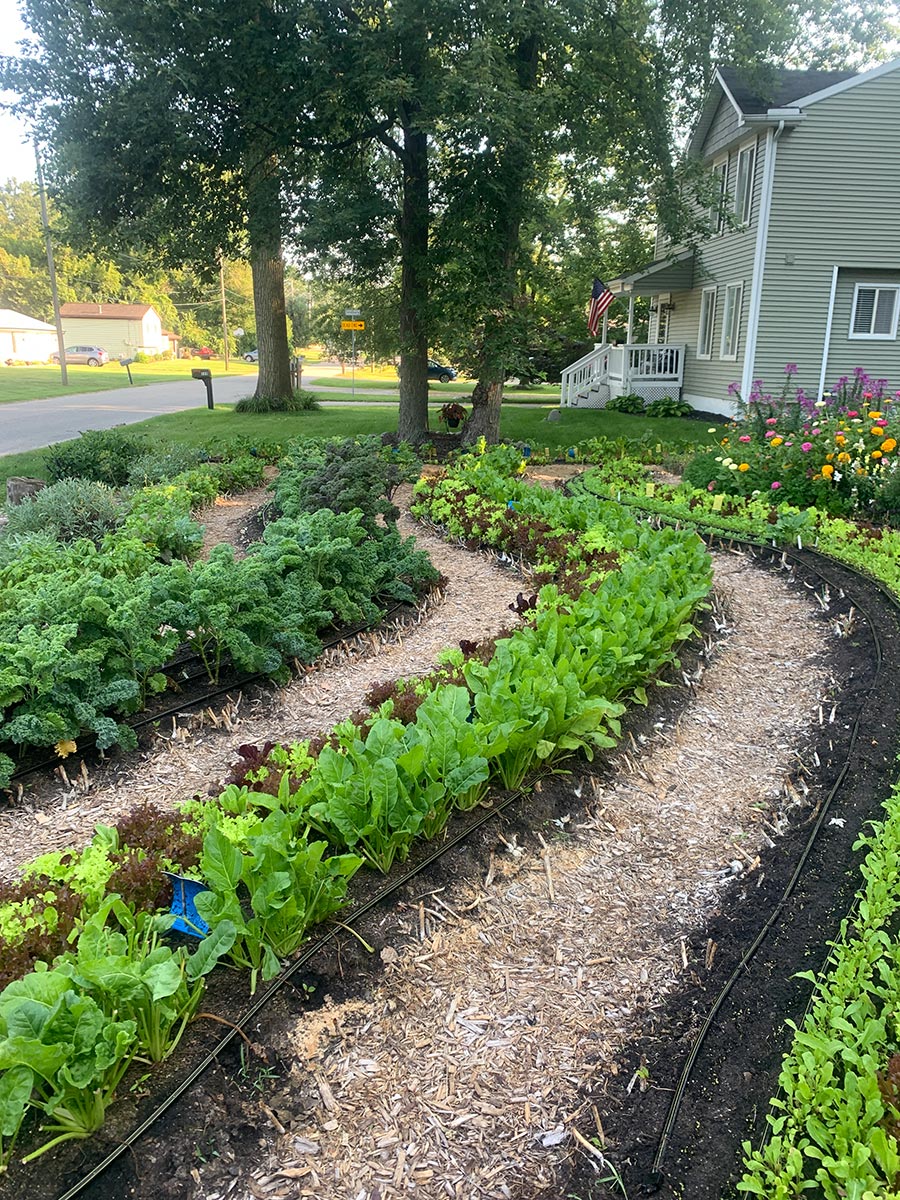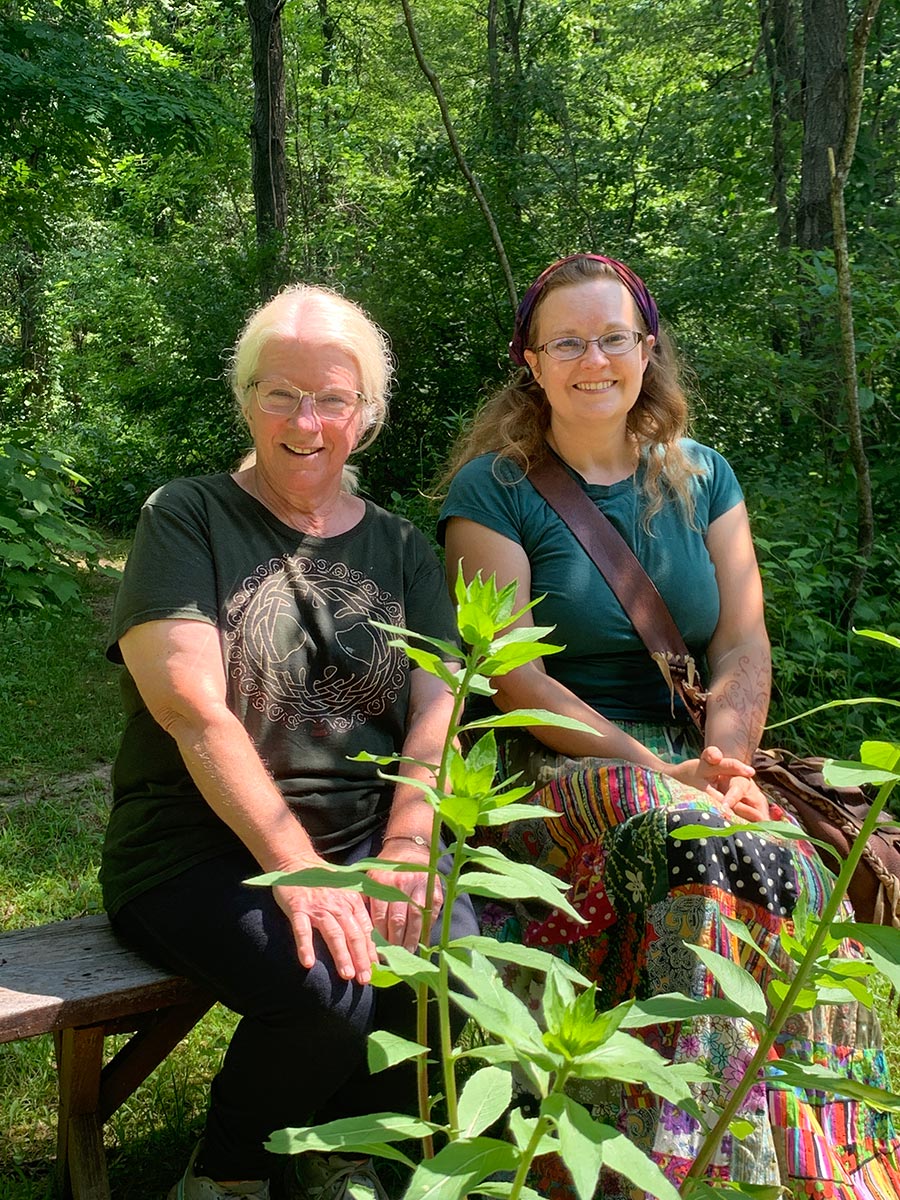
Six years ago, I shared about Natures Harvest Urban Permaculture Farm, a front-yard garden located in the Detroit metro area. When I shared this post, Linda was in her first year of gardening in this new location, and was regularly selling her produce at a local farmer’s market and engaging with her community. Here are links to my first two posts about her incredible garden that discusses the original process, design: Nature’s Harvest Urban Permaculture Farm and Return to Nature’s Harvest Urban Permaculture Farm.
A few weeks ago, when I was visiting Linda, I shared some photos of her garden to my social media, and many people responded by saying “she must not have a homeowners association”, “ how did she not get in legal trouble?”, or “my township would make me tear that down!” The questions and comments of this nature just kept rolling in. In fact, Linda is now in her sixth year of her front yard garden with no issues or complaints from neighbors, etc. Thus, I thought it would be useful to interview Linda and learn from her about how she was able to have this incredible front-yard garden in a suburban area, explore some strategies that she used, and share those strategies with others. If more of us can do the kind of thing Linda is doing—converting lawns that consume resources to gardens that provide food for people and wildlife, nectary sources for insects, and so much more, we can really begin to make positive change in this world and vision a brighter future.

Dana: Tell me about your vision for Nature’s Permauclture Urban Farm.
Linda: As I’m seeing it evolve, the word permaculture plays an integral role. Because we need to build community, protect the environment, and people can also learn how to make a sustainable future, sustainable income, and way of sharing knowledge with others. That’s why I wanted to convert my lawn. I wasn’t only about food but about cultivating good habits and activities.
Dana: You were originally an organic farmer farming 10 acres, right?
Linda: Yes, so when I moved here, I moved from 10 acres to a 50×50 growing space. I brought a lot of what I knew but here, because it was so visible, I wanted to make it aesthetically pleasing. I wanted to make it “landscapey” but not a traditional landscape. But I knew it had to be very visually appealing to the eye.
Dana: You are on the edge of a small town in suburbia, in the middle of a suburban neighborhood. And you have this front yard garden that everybody can see. So, tell me about your garden.
Linda: When I came to the place, I was just thinking that I needed a place to put my hands in the soil. I stood out in the middle of the road and I said, what can I do with this? Its only 50×50. So I said to myself, “Ok, I’m going to create a garden. But it can’t be a boring square garden.” I’m not into lines, I’m into curves. The earth isn’t straight, its curvy. So, it was something where I said—I need food, my community needs food, I want wildlife comfortable here: insects, frogs, snakes, dragonflies, etc. So when I created the garden, I was thinking about both wildlife and people and their needs. And really, I wanted to be happy in nature when I walked out of my front door, rather than seeing the lawn.
Dana: So you essentially transformed this lawn, plain grass, into this amazing garden. Do you have a sense of how much food you are producing?
Linda: On average, enough to feed 20 or 30 people from the greens each week, thousands of pounds of produce per year. So for the first five years, every week, I was going to the farmer’s market. And I had more than enough for that capability out of this garden. Now, I’m doing the market every other week.

Dana: So you are literally able to go to the farmer’s market each week and sell just from this 50×50 square foot space? This really tells readers just how much you are able to produce here.
Linda: I do French intensive agriculture methods, which includes succession planting and companion planting. While I can’t be certified organic here, I use all natural methods for pest control. These include using yellow and blue sticky plates for bug control, neem oil, cayenne pepper for slugs, dog hair to keep out rabbits, and much more.
We do have 4000 acres of wild lands behind this neighborhood, but the protocols that I use here keep the deer away. I use onions lining every bed and herbs (sage, thyme, and lavender) lining the garden. I don’t have any fencing, because that would detract from the beauty of it. I can sell and give the herbs away too, and they keep away the deer, and they also provide food for pollinators.
Dana: Obviously there’s a lot of people out there in similar circumstances to what you are in: they live in suburbia. They have a very small space, maybe 50×50 or even smaller. And they are looking at this lawn and saying “this isn’t sustainable” and they are looking to grow some food and cultivate some habitat. But at the same time, in this region, we have several examples of families that have put in a front yard garden only to have their township make them bulldoze it. Can you talk us through the steps that you did to come to this place where you had a very successful front yard garden that is welcomed by your community? Specifically, how did you navigate the laws, ordinances, and neighborhood requirements?
Linda: This garden is now six years old and I’ve never had a problem with neighbors complaining or the township. Basically, when I stood out and looked at my new home, I had about a month to get everything in the ground before winter came. I realized that I was the new person on the block, so I had to introduce myself to the neighbors. And some way or another, I had to tell them what I was planning on doing. I had the vision in my mind, and I knew what it was, but I needed them on board. So I took them cookies. I took them lavender lemon shortbread cookies and I opened up a conversation with them. I told them I was planning on making a garden in my front yard.

I also drove around the town to see if there was anyone who was doing something similar in my town. I saw 2 or 3 places where someone was doing something like this in their front yard, but more landscaped. But I noticed that these didn’t have a focal point, or a flow. It wasn’t beautiful enough. It was choppy. I had to think about the long term: the shade, the rain, the sun, the water, the wind, but also the people and how they perceive it in all of the different seasons.
I next went to the township and I asked them, I’m thinking of putting an edible garden landscape in my front yard. I didn’t call it a garden, I called it an “edible landscape” which may have helped. I spoke to the head guy in zoning, he says, you can do that as long as there are no weeds growing. He gave me a piece of paper with the ordinances and I took it home and read it. It said anytime you put more than 5 yards of soil down, you have to have approval. But soil is not compost. Soil has rock that’s broken down, minerals, etc. Compost is leaves, plants, and brush that is all organic matter. So, if I put compost down and not soil, I can get away with it.
Dana: So it was kind of a technicality but it worked.
Linda: It was a technicality but I could win on it if anyone wanted to challenge me. So once I got the OK from the neighbors (because they could turn me in anytime they wanted) and I got the OK from the township, I went for it.
When I moved in, the front yard had one large and two small ornamental trees. I had these taken down and mulched so I could use the mulch in the gardens and in the paths. In other words, all of that organic matter was put right back on the property.
But back to the landscape. I knew that if this was going to be successful, I had to make something extremely visually pleasing so that the neighbors won’t complain. I decided against raised beds like I did in the past because that’s too constrictive and it’s something they are used to seeing and it may look too much like a garden. I saw how my elevation mattered. The two houses on either side of me were higher, so I was in a low area. And so I had to make it contour. I did a combination of curves and wood chips, that way if I had heavy rains, I wouldn’t have any issues and the water would be able to soak right in.

But when things started happening, people were walking by. They would stand and stare. Little kids would come, and they wanted to play. The paths were like an energy run for them. They just wanted to run thorough those curvy paths.
What I have found out is that people think its work. But little children see it a form of play, they want to play and help. So that makes it fun for them.
Dana: I want to focus on the aesthetically pleasing aspects because these seem to be one of the key aspects that can really help you do this. It’s not just about growing vegetables and replacing the lawn. It’s about inhabiting a space in a way that makes it truly beautiful. When people stop, rather than say “look at this garden that looks like an eyesore” they say “wow!” Can you say more about that? How do you create that?
Linda: It’s a good question, because in my previous farm, I had 10 acres that was far from neighbors. And my farm there was very constricted. They were square with lines. And I realized that that’s easy because its farming. A lot of arms are really functional, but not necessary aesthetically pleasing.
And so I drew upon some of the things that people would do to a typical lawn and typical front yard. But to not have it visually dead with lines. I needed something that would come alive, that the eye would move through the space, just like a nice piece of artwork. There’s something about the eye enjoying flow, the curve.

For example, my feeling was, to have flowers in the front, so when I looked out my window I could see insects and bugs and they would be beautiful next to the house. Flowers with long bloom times so that something was always blooming during the summer.
Dana: Yeah, you really can see that when you walk up to your garden—your Yarden. It does take you in. The waves and the curves really take you in.
Linda: Yeah! I kept playing around with these designs and the garden evolved. I tried different angles, to figure out how it would look good from the side, from behind, from within it. The goal was to make it good from all of these different angles and offer a visual experience.
Dana: That’s really important to people. Because for your neighbors, they don’t want to feel like their home values are being degraded because of someone’s front yard garden or an unruly yard. So, from what you are saying, if you are going to do this work, you have to do it in a way that is very visually appealing to people.
Linda: Yes. You are right because one of my siblings, when I was planning this, she said to me ‘Linda you are going to have to tear this apart because nobody is going to like it.” So she was a naysayer before I started it. Once it was done, and the curves were there, dark black compost flowing around, and the contrast of the paths, then she said “Well, we’ll see what happens in the spring.” And then, my neighbors were asking, what’s going to happen in the spring? And the lady across the street said, “Just watch.”
So the overall design is this: the flowers next to the house are the accent point. The greens are flowing with the paths. You get a lot of eye entertainment. And I don’t have your typical landscape flowers: there are no lilies, Hostas, etc. That seems to be the go-around for everyone’s yard around here. I said, Hollyhock! The old-fashioned stuff, pollinator friendly, things that they haven’t seen before.
Dana: How do you continue to engage in a dialogue with your neighbors about this garden? We were out there just a little while ago and one of your neighbors stopped by, and talked to you when we were out there!

Linda: I’ll tell you what. That was the part I didn’t mentally think about when I started doing this. I started doing this for my own gratification, to keep my energy flowing, and to get my hands in the soil, for my exercise and health. But then the neighbors started asking, “hey, can I have some of your produce?” For example, one of my neighbors stopped by last night for kale and salad greens. My other neighbor is pregnant and loves cucumbers; I make sure she gets them. The neighbor girls on the other side here love eating raw cucumbers. So, it was a just a matter of putting it out there. Recently I had some organic farming students from Oakland University come to learn here. East River Organics wanted a design done, which I worked on, and they brought the person who was going to implement the design out to take a look at my garden, because this is what they wanted to do for a new project to do garden outreach to differently abled people.
So I’m at that step now, where, after five years, I know it’s happening and its ok. And it’s starting to really bring people in! Someone asked me, why am I not in the newspaper? I don’t know! I’m not quite ready for that.
Dana: Well at this point, if you were going to get in trouble for the garden, it would have already happened. And, I think what’s key here, is that you engaged in a dialogue with the right people early on, and you continued to have a positive relationship with your neighbors. But it sounds like if you want to be successful at doing this, it’s about doing that ongoing engagement work first and foremost, rather than just doing it on your own. You live in a community and you have to engage in that community as you are planning and implementing your garden.
Linda: Yes exactly. One the big comments I get is about how much work it is. A lot of my neighbors work and say “I don’t have the time to do this.” It’s hard, the word “work”. I don’t really see this as work.
Dana: Can you talk a bit about the backyard? I know you have a food forest going back there.
Linda: I have a space about 25×50 back there and its evolving. I have a sugar maple overstory. I have three paw paw trees, raspberries, black cohosh, strawberry, sweetgrass, other understory plants. I have ramps, from you, thank you. I share how to harvest them with the kids—just take a piece of the leaf. These are things you don’t see at the store. When the pawpaw come into fruit, which should be next year, it will be a wonderful chance to educate the kids.
Dana: It sounds like you have more annual sun agriculture in the front and shaded perennial agriculture in the backyard. And you’ve gotten rid of almost all of the lawn.
Linda: Yes, just enough to have some paths or for someone to park their car if necessary. But there’s no reason for more lawn—I am converting every bit of it into something that benefits nature and the community.
Dana: I know you are transitioning away from the farmer’s market and working to make this more of an educational space in the future. Can you share more about that?

Linda: Yes, that’s where I will be needing to do more promotion. I’ve already connected with many people in my area who are interested in organic practices. The garden is also a big draw to children; children see vegetables in the grocery store, but I’m growing some different things that are really exciting to them. Like the Asian long bean, it’s over a foot long. The kids come up, I give them a bean, and they walk away happy. It’s like candy to them!
So for me, the next step is working less on the market gardening and more on educating, promoting, teaching others how to do this. If someone wants to break up their landscape, there are so many things that they can do that will still look visually appealing and move them away from the lawn. For example, blueberries.
Dana: Let’s return to this idea of work and a garden being “too much work.” So tell me about the work of this?
Linda: Well, you don’t have to mow your lawn if there is no lawn to mow! And I get plenty of exercise and have no need for a gym membership. This garden is my workout. It is physical, but rather than lifting weights, I’m lifting soil or compost! Mulch! Especially as I get older, it’s also a way for me to stay healthy and strong. I also see it as meditation. I am out in the sun and getting my Vitamin D. I am keeping myself moving, I’m not rickety or creaky. I can move 10 yards of compost, even in my late 60s!
Dana: It does seem like there are so many benefits: food you are producing, an income, the exercise, educating people, not having a consumptive lawn, meditation, health benefits, providing a vision for the future. Showing all of this in a way that demonstrates that it can be sustaining, and joyful! There just seems like there are no reasons not to do this!
Linda: Yeah! I love the way you presented that thought. That’s what it is all about for me. I am so happy that this garden is such a place for joy. I have a tendency to be modest, but I do think that the front yard garden speaks for itself. I am speaking through the language of my garden.
Dana: Well, thank you so much for your time and expertise, Linda!
To conclude, Linda’s garden is really a source of joy for all who visit it. And somehow, she has found a “magical formula” to living in a suburban area with hosing restrictions, codes, and township laws—through cookies, through making it visually appealing, and through always thinking about the needs of her community.




Reblogged this on Paths I Walk.
This is wonderful, thank you, both of you! 💚
You are most welcome, Juliet! Thank you for reading!
How beautiful the front yard garden is!! I wish I owned my own property and could grow beautiful things too… you live in a Paradise! Lovely pictures. 🌹🌹🌹💚💚💚💚🦋🌲🌳
Thanks for reading, Deborah! :). Perhaps someday that dream will come true for you!!!!
I thought you might enjoy this.
On Sun, Sep 5, 2021 at 6:33 AM The Druid’s Garden wrote:
> Dana posted: ” Six years ago, I shared about Natures Harvest Urban > Permaculture Farm, a front-yard garden located in the Detroit metro area. > When I shared this post, Linda was in her first year of gardening in this > new location, and was regularly selling her produce” >